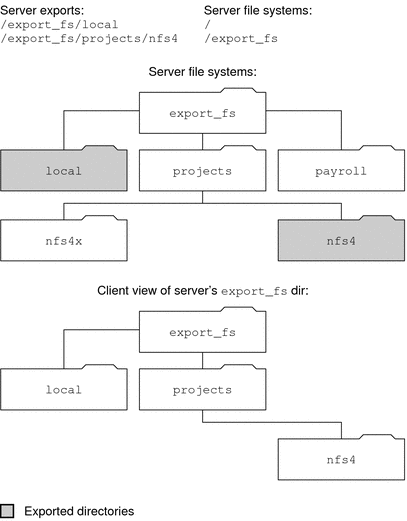File-System Namespace in NFS Version 4
NFS version 4 servers create and maintain a pseudo-file system, which provides clients with seamless access to all exported objects on the server. Prior to NFS version 4, the pseudo-file system did not exist. Clients were forced to mount each shared server file system for access. Consider the following example.
Figure 6–2 Views of the Server File System and the Client File System

Note that the client cannot see the payroll directory and the nfs4x directory, because these directories are not exported and do not lead to exported directories. However, the local directory is visible to the client, because local is an exported directory. The projects directory is visible to the client, because projects leads to the exported directory, nfs4. Thus, portions of the server namespace that are not explicitly exported are bridged with a pseudo-file system that views only the exported directories and those directories that lead to server exports.
A pseudo-file system is a structure that contains only directories and is created by the server. The pseudo-file system permits a client to browse the hierarchy of exported file systems. Thus, the client's view of the pseudo-file system is limited to paths that lead to exported file systems.
Previous versions of NFS did not permit a client to traverse server file systems without mounting each file system. However, in NFS version 4, the server namespace does the following:
-
Restricts the client's file-system view to directories that lead to server exports.
-
Provides clients with seamless access to server exports without requiring that the client mount each underlying file system. See the previous example. Note, however, that different operating systems might require the client to mount each server file system.
For POSIX-related reasons, the Solaris NFS version 4 client does not cross server file-system boundaries. When such attempts are made, the client makes the directory appear to be empty. To remedy this situation, you must perform a mount for each of the server's file systems.
- © 2010, Oracle Corporation and/or its affiliates
